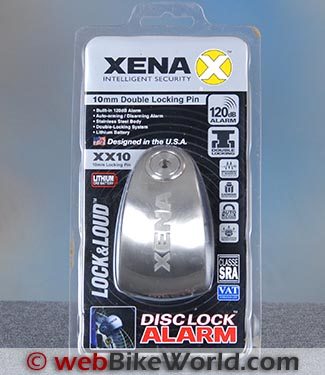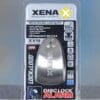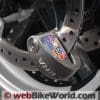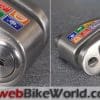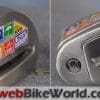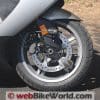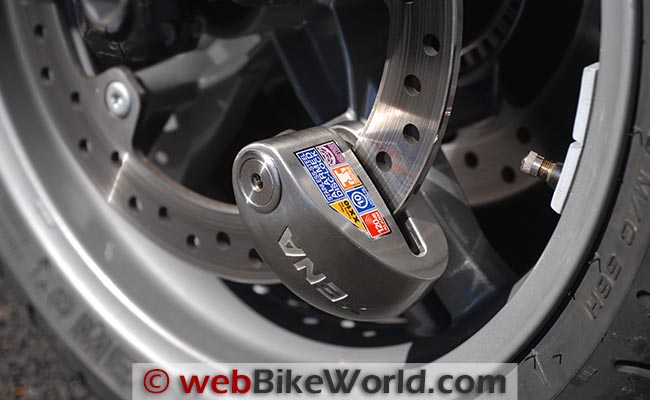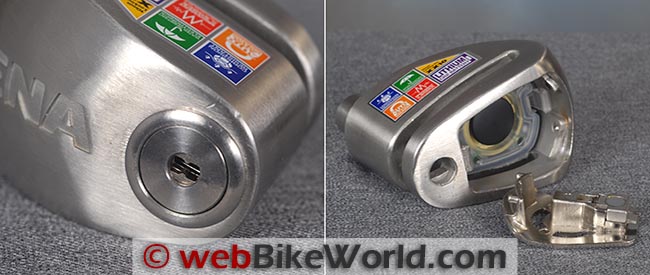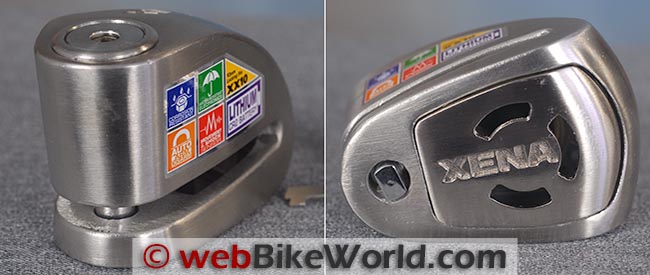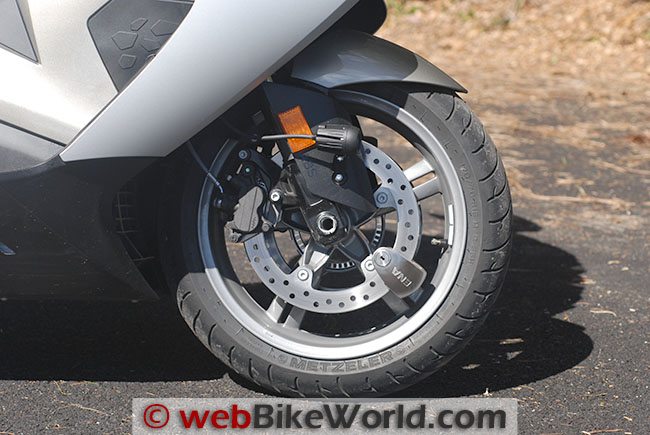The Xena XX10 is the latest evolution of a successful series of motorcycle disk lock alarms.
The XX-series has been updated with several features.
Like the other Xena disk lock alarms, the lock is independent of the alarm, so a dead battery has no effect on the locking attribute.
The XX10 is easy to use and the alarm has been de-sensitized slightly to reduce false alarms.
We have reviewed several other motorcycle disk locks, disk lock alarms and other types of security systems over the years.
In fact, there are now so many reviews that a “Motorcycle Alarms, Locks, Immobilizers” page was created to list them all.
Included on that page are the webBikeWorld reviews of the Xena XX14 (review) from 2009, the progenitor of the XX10, and the Xena XN15 (review), another similar design from 2008.
Xena has updated the XX-series motorcycle disk lock alarms, which now includes the XX6, XX10, XX14 and XX15.
Each disk lock alarm in the XX series has the same shape; the differences are in the size of the locking pin and the overall width and height of the body.
Many motorcycle or scooter disk brake rotors have large slots that will fit the largest size Xena disk lock alarm.
But the critical factor to be considered (at least for the operation of the alarm) is the placement of the reflector system in the lock.
The disk rotor must cover the reflector for the alarm to arm itself and work correctly.
Xena publishes the dimensions of each disk lock alarm on their website and they also had a “Does It Fit My Bike” automated chooser on their website that isn’t currently operational, for some reason.
Notes on Motorcycle Security
As noted in previous webBikeWorld reviews of motorcycle security products, no one device is a guarantee against theft or mischief.
A “layered” security system is the best approach, and a disk lock or disk lock with alarm is one layer.
A disk lock alarm like the Xena XX10 or other XX-series locks is easy to use, and ease of use is one key factor in a successful security strategy. The logic is simple: if the product can’t be deployed with little effort, chances are it won’t be.
And if it isn’t, it can’t protect.
The more layers you have in the system, the more secure your motorcycle or scooter will be.
The UK’s “Ride” magazine (April 2013) includes extensive coverage of motorcycle security and related issues and they outline the layered approach to security.
This includes everything from the obvious, like disk locks, chains, garage anchors, locked and barred garage doors, etc. to the not-so-obvious.
Those include things like parking the bike or scooter in different locations to be unpredictable; using a bike or scooter cover and making sure the chains aren’t touching the ground and arranging the locks or chains to make it harder for a thief to access with cutting tools.
Again, no single device or even a layered security system provides a guarantee against theft.
But the theory is that anything that adds complexity to the thief’s work — and they’re usually in a hurry — will make them reconsider taking your bike or scooter and move on to the next poor sucker’s two-wheeler instead.
When Dr. Ken German, who worked for the Metropolitan Police in the UK and who is a vehicle crime consultant, was asked the rather clumsily-worded question “What’s the very least security someone should have on their bike?”, the answer was “A disc lock on the front brake.”
Updates to the Xena XX10 and Xena XX-Series Disk Lock Alarms
Xena took webBikeWorld owner feedback and improved the XX14 over the XN15 and they’ve done it again with the updated XX-series.
It’s always good to see a company continuously improve its products and Xena gets a lot of credit for doing just that.
Xena told us that the improvements to the XX-series now include the following:
- The old mechanical ball-bearing based motion sensor (that made the module rattle when shaken) has been replaced with a new software-based accelerometer.
- The piezo shock sensor and the new accelerometer are now installed on a U.S.-made integrated circuit board.
- The circuit board is now covered with a silicone gel coating that enhances both weatherproofing and shock-proofs the components.
- The lid of the module itself is now fastened down with four steel screws, rather than an adhesive, with a silicone seal that also greatly improves weatherproofing.
- The new accelerometer, because it is driven by software and therefore programmable, is accurate to within one degree of movement through space in our case to movement of seven degrees).
- The accelerometer accurately measures movement through four axes.
- The shock sensor has been recalibrated to be slightly less sensitive and virtually eliminate false alarms.
- The behavior of the alarm was modified; when the battery is installed there is a 30-second period of single low-volume beeps to allow the component lid to be put back in place.
- All these changes have improved the accuracy, reliability and longevity of the alarm module.
Xena XX10 Alarm Module
The Xena XX10 is typical of the XX-series disk lock alarms. The 10 mm diameter locking bolt fit on several different disk rotors, from the BMW C 650 GT scooter (blog) to the Suzuki DR650 (blog)and other two-wheelers.
The XX10 can be easily carried in a tank bag or compartment on the bike.
Xena advises not to store the lock in a jacket pocket or on your person, as it can cause harm if you’re involved in a crash. Some owners wrap their Xena lock in a sock before placing it in the tank bag or luggage compartment.
This helps reduce rattling and dents.
The XX10 weighs 623 grams (1 lb., 6 oz.) without the key and it can be attached to the rotor in seconds.
The trick is remembering it’s on the rotor when you return to the bike or scooter, but the alarm will help you remember that or you can add a ribbon or something to the handlebar as a reminder.
The XX10 has the same “organic” shape as previous Xena disk lock alarms. This shape is designed to help defeat saws or other cutting tools.
The body of the larger XX-series locks is molded from stainless steel and the 10 mm locking pin on the XX10 (and the pins on other XX-series disk lock alarms) is a “double-locking, carbide-reinforced hardened-steel locking pin”.
The lock itself is “pick-resistant” and has a “freeze-spray resistant key and barrel”.
The locks come with three keys and a separate key-like device to release the battery cover. The battery is a CR2 lithium, claimed to last about 8 months (replacements cost approx. $3.50 to $5.00 at discount).
Using the Xena XX10
The XX10 works just like the other Xena disk lock alarms. It comes with the battery installed and it can be used immediately.
Note that the alarm is independent of the lock; the lock will still function if something happens to the alarm or if the battery dies.
Open the pin lock with the key and slide it on the disk rotor. The only “trick” is making sure that the rotor must be 7 mm thick or less (most rotors are less) with a slot big enough to hold the locking pin.
This is the case with most front rotors; however, we noticed that the slots on some rear brake rotors may be too small to fit the “throat” of the XX10.
The alarm will chirp as the lock slides over the rotor. This signifies that the alarm is arming and gives the owner a chance to secure the lock on the rotor. After about 5 seconds, the alarm is armed.
Our XX10 has a curious idiosyncrasy: the alarm will chirp if the XX10 is held in a certain orientation on a sunny day. Apparently, the light from the sun interferes with the arming device. This is illustrated in the video below.
What’s even more strange is that this doesn’t happen if the lock is held in the sun through a window, but only when the lock is outdoors.
[UPDATE: Xena said a UV filter is being installed on newer XX-series locks to help prevent this quirk, which doesn’t otherwise affect the performance of the lock and does not induce false alarms.]Xena said the revised XX-series alarms have been desensitized slightly and the internal alarm mechanism has been upgraded to help reduce false alarms, a problem with earlier series.
This seems to be true and you can see in the video the kind of movement it takes to trigger the alarm.
The owner’s manual also suggests that if the XX10 is mounted in the 6 o’clock position, more effort is required to trigger it, while mounting it in the 12 o’clock position will increase the sensitivity.
This is difficult to gauge but appears to be so and this is also illustrated in the video.
Conclusion
The Xena XX10 disk lock alarm is a modest upgrade to the original XX-series. It’s easy to use and seems well made and it fits easily over any of the disk brake rotors we tried.
The alarm is loud, as it is on the other Xena alarms. The alarm module can be replaced if necessary but the lock works independently of the alarm.
The XX10 is noticeably less susceptible to false alarms.
The XX10 is relatively expensive but the quality and reputation of Xena, along with the popularity of the XX-series disk lock may be worth the extra cost over a “no name” brand.
| wBW Review: Xena XX10 Disk Lock Alarm | |
|---|---|
| Manufacturer: Xena Security | List Price (2013): $104.95 |
| Colors: Stainless Steel or yellow painted. | Made In: China |
| Review Date: March 2013 | |
Note: Item provided by a retailer, distributor or manufacturer with these Terms and Conditions.
Owner Comments and Feedback
See details on submitting comments.


